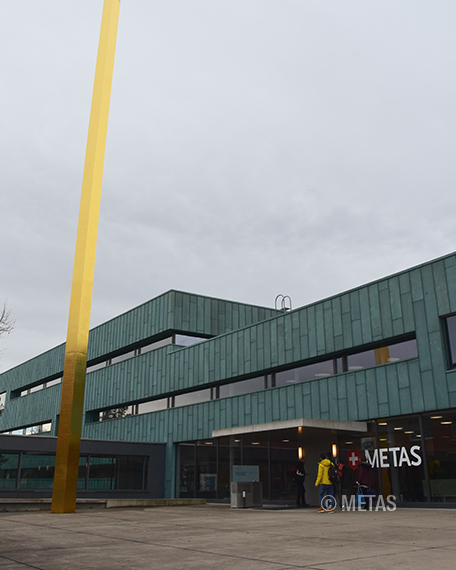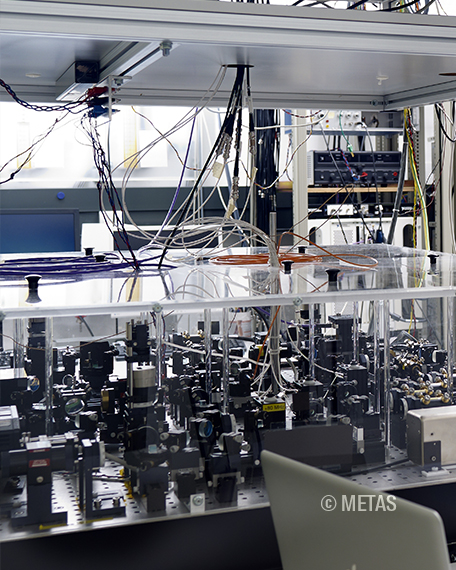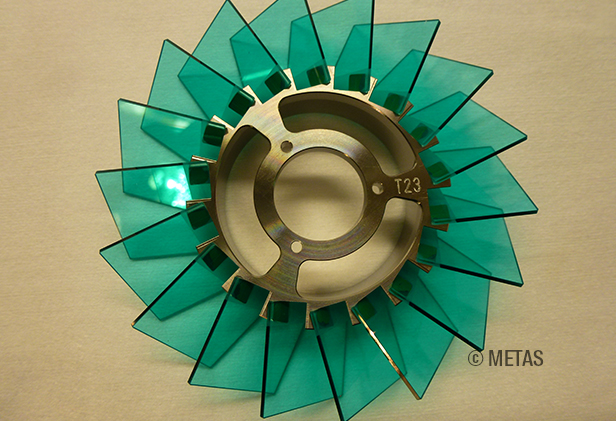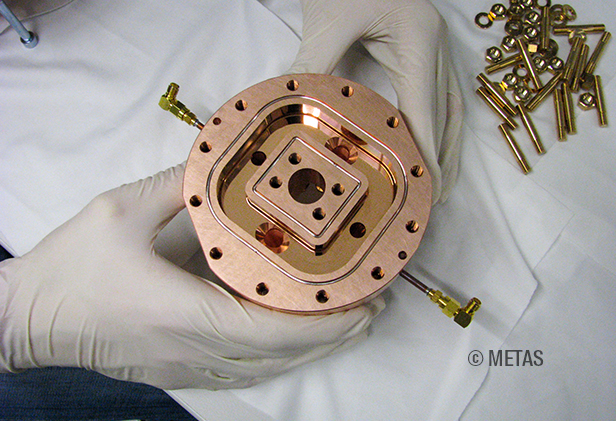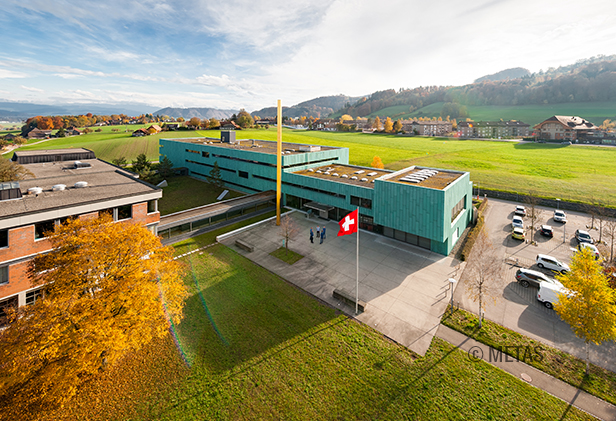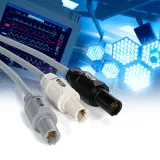The Swiss time factory
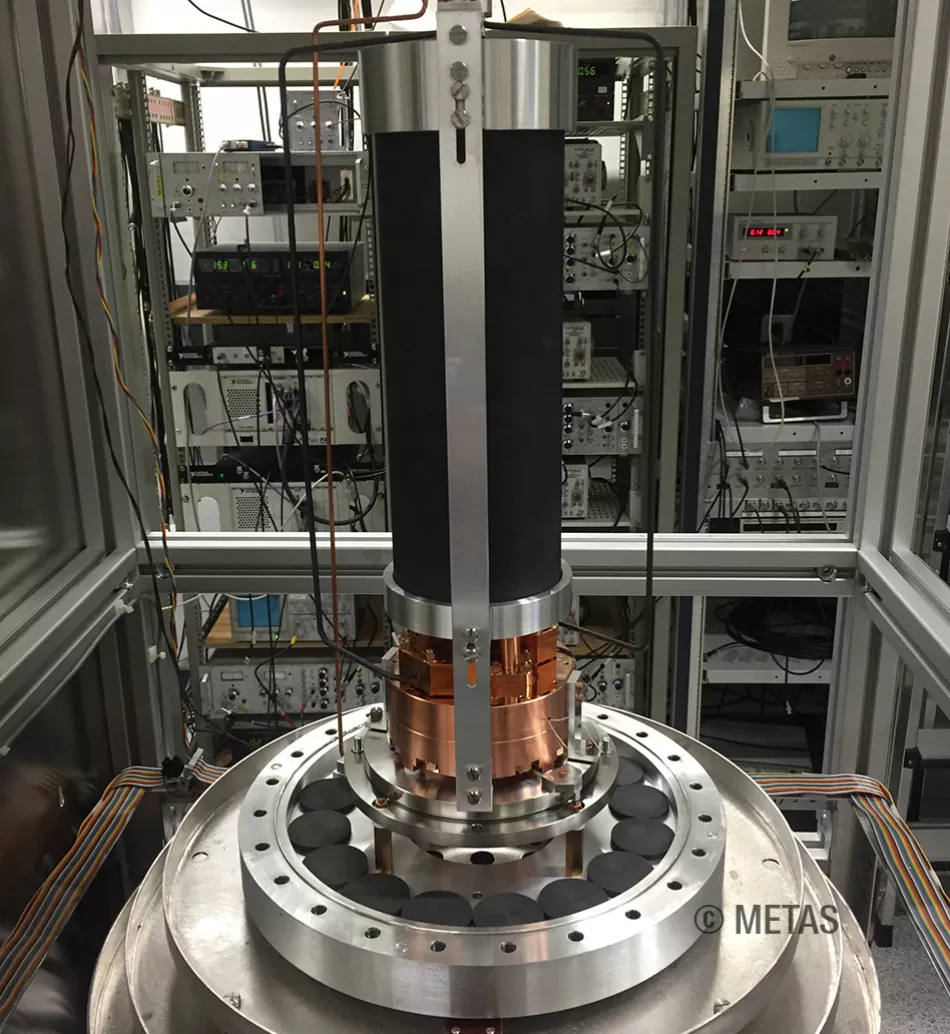
Visit to the laboratory where Switzerland is creating time, where a complex timepiece, unique in the world, is juggling with atoms to capture light and fragile seconds are flirting with millions of years.
In the heart of the country of precision, there is a place that claims to be the most accurate of all: the rather official METAS, Swiss Federal Institute of Metrology.
The institute is nestled on the outskirts of the capital city of Bern, in a quiet, green valley. It was built there on purpose, away from the urban noise and vibrations that could interfere with the measurements carried out in the laboratories.
The red-brick buildings date back to the sixties. From the top of their tower, you can see the Federal Palace, the headquarters of the Swiss Government. The green copper buildings of modern minimalist design were inaugurated in 2000. In front of the main entrance, a 60 cm square and 24 m high obelisk, covered with golden sheets, was erected, alluding to seconds, minutes and hours.
Time is exactly what we have come for.
At METAS, time and frequency are the business of the photonic laboratory : a team of eight people, including our guide, the physicist Antoine Jallageas. Their mission is the same as that of their 230 colleagues : to define and share measurements so that everyone can use them, coupled with the verification values measured by the others and, where appropriate, issue certifications.
However, time is a rather peculiar value, since it flies, by nature.
For a long time, measurements were based on astronomy. The second was defined as a fraction of the revolution of the Earth around the Sun. However, the rotational speed of our planet is subject to natural variation, so it is impossible to fix a stable second. In the middle of the 20th century, such uncertainty became intolerable for a variety of needs (science, space, telecommunications…). So, like for other metrological values, scientists were looking to define a second by an unchangeable constant.
"An English team worked on it for four years ”, says Antoine Jallageas. “ They laid down the definition of the second, adopted in 1967 by the General Conference on Weights and Measures ”. Created in 1875, this institution is metrology’s decision-making body.
The selected constant comes from atomic physics: the transition frequency of the caesium 133 atom. “ When this atom passes from an energy level to a lower energy level, it releases a wave ”, explains the physicist. The frequency of this wave is 9 192 631 770 Hz. This is the number of times the tiny wave – frequency wave in scientific language – recurs every second. “ Thus, the second is defined as 9 192 631 770 periods emitted by the caesium atom. ”
The definition is precise, but only theoretical. It doesn’t give you time, nor does it enable you to time your kid’s runs. No more than the definition of metre – based on the speed of light – makes it possible to measure the size of your apartment. The measurement standard needs yet to be produced and then shared, used to measure, compare and verify. This is what metrologists call “ realising the definition ”.
Antoine Jallageas leads us along METAS’ maze of corridors. Straight corridors lined with wooden cupboards and hundreds of doors. One of them opens into a huge cubic isolation room, fitted with cones made of foam. An engineer installs the microwave oven and controls its emissions. Elsewhere, in a display case, there are breathalysers used by the Swiss police, certified by METAS as complying with legal requirements. Further on, posters present to visitors how decibels are measured. The institution covers every aspect of our daily lives, which is only natural : rules and regulations, standards, technical descriptions and user guides, drug dosage or quality controls are studded with units of mass, length, current and temperature… Metrology is the guardian of a world of numbers, so omnipresent that we tend to forget about it.
A staircase leads us to the basement of the modern aisle of METAS, where some of the most sensitive laboratories are sheltered, away from the interferences of the outside world. “ The floor rests on an independent concrete slab, which reduces vibration ”, explains Jallageas. “ Temperature, which is the most sensitive factor for us, is stabilised at 22°C and does not deviate more than 0.1°C over the year. Laminar air flow prevents variations and draught. ”
One last door and we arrive in a narrow corridor. This is the hallway to the two time-laboratories, each one unveiled through a large pane of glass.
In the first laboratory, there are rows of tables with five suitcasesized rectangular machines on them – atomic clocks. More precisely, two caesium clocks, two passive hydrogen masers and an active hydrogen maser (which stands for microwave amplification by stimulated emission of radiation).
“ It is with these clocks that we generate UTC-CH, the Swiss time. Also, for the past 30 years, we have been contributing to UTC (Coordinated Universal Time) by sending to BIPM their status, the measurement of their deviations ! ”
The BIPM (International Bureau of Weights and Measures) located in Paris, gathers and compares data from hundreds of these atomic clocks located around the world, guaranteeing high measurement stability. It then translates it into International Atomic Time (TAI, from the French name temps atomique international), resulting in UTC time, which determines time zones, enabling the world to coordinate our clocks and our lives.
Do these atomic clocks create “ the ” second ? “ Oh, no ! Creating “ the ” second requires much more precise clocks than these commercial devices. ” These clocks are much more rare and are called primary frequency standards. “ There are only about twenty of them in the world ”, adds Jallageas stopping in front of the glass pane of the second laboratory. “ And here is one of them ! ”
In the room, there is a multitude of instruments and dials, as well as a forest of cables to connect them. Two elements stand out : a 2-meter high metal cupboard protecting a large cylinder – the actual clock ; as well as a rectangular table, topped with a Plexiglas case filled with black elements and small mirrors – the optical table.
These eclectic elements form the “ Fontaine Continue Suisse ” (FoCS), one of the most precise caesium clocks in the world.
The FoCS was developed in the early nineties, in cooperation with the University of Neuchâtel. It is no coincidence, for the canton of Neuchâtel has amassed centuries of expertise in time management. Namely, it is the birthplace of many major watch brands and a world-renowned competence centre for atomic clocks. 20 years of research and millions of Swiss francs were necessary to design the FoCS and to get it approved by the exclusive club of primary frequency standards.
Seemingly preposterous,
but necessary precision
Why spend millions on developing primary frequency standards ? Why waist a month creating a second and then start it all over again ? Why push accuracy as far as 14 zeros after the decimal point ? Not only for the sake of scientific beauty. Even if, as Antoine Jallegeas readily admits, it is also a matter of prestige.
The extreme precision of the second – the greatest of all the International System of Units – is pivotal, for more than one reason.
First of all, the second is indispensable for creating other units like the metre, the kilo, the ampere, the kelvin and the candela. An inaccurate second could make the whole of metrology falter.
Secondly, an important number of applications, necessary for our societies’ normal functioning, require such a level of accuracy.
Geo-positioning is the most recurring example. “ One nanosecond of inaccuracy is translated into several dozens of centimetres on the ground ”, says Jallageas. “ There would be no GPS without atomic clocks in satellites. ” Other sciences, such as spectroscopy and geodesy also need exact time to be able to push their current limits.
By unifying the world and extending exchange, globalisation has also generated a need for finetuning the coordination of time. Telecom technologies and infrastructures (from smartphones to satellites), for example, could not function without precisely synchronised time.
With multiplying and accelerating financial transactions, it has become hard to ensure traceability. The European Union has enforced timestamping with microsecond precision to be able to identify and authenticate them (MiFID directive II). Banking institutions are equipped with accredited data centres and they can benefit from services provided by control bodies, such as METAS, in order to verify their time scales.
Even an everyday action like switching on your bedside lamp is subject to the accuracy of the second. Without precise and coordinated time, electric networks – now interlinked on a continental level – would be much more unreliable. For instance, it would be impossible to detect unbalanced production between Northern and Southern Europe at an early stage, to avoid a blackout or any major network failure.
Tomorrow, our societies will need an even more accurate second.
New clocks, using transitions in the field of optical frequencies (light frequencies), are able to reach 10-17 or 10-18 accuracy, which means a deviation of one second in 3 billion or even 30 billion years ! These clocks, which are still at an experimental stage, have not been recognised as primary frequency standards. However, their very promising performance makes them seriously eligible for a new definition of the second.
Other devices, such as nuclear clocks, could even exceed their capabilities. In a nuclear clock, frequency transitions are measured directly inside the atomic nuclei. The atomic nucleus ensuring better insulation against external disturbance, frequencies could ensure higher levels of accuracy than those of optical clocks. However, these developments are still at a very early stage.
So, it will take a little longer before we get the new second. Meanwhile, it is the current 53-year-old one that continues ticking away.
How does such a clock work ? In a nutshell : caesium atoms are tossed upwards along a parabolic trajectory and the frequency of their transitions is measured. It can be the subject of a physicist’s entire career. Antoine Jallageas, enthusiastic and inspiring, described it for at least 20 minutes, interspersed at regular intervals with a polite “ I won’t go more into the details, since it’s a bit technical ! ”, but here’s an attempted summary.
On the optical table, seven lasers generate sixteen infrared beams (852 nanometres). These beams, transported by fibre optics to the fountain, decelerate the caesium atoms, which cools them down to a temperature close to absolute zero. A laser tosses them upwards. They pass through a microwave cavity where they are exposed to a frequency close to their transition frequency.
When the atoms fall back, they go through a laser, where the atoms that will have transitioned, emit light, measured by a sensor.
Little light means that only a few atoms have transitioned, so the frequency is corrected to increase transition probability. Then it starts all over again, until the sensor indicates that a maximum of atoms have transitioned. Once we get there, it means that the frequency in the microwave cavity is equal to the transition frequency of the caesium atom. Bingo : the second is realised.
The name “ fountain ” was given to this type of clocks with reference to the fact that the atoms are tossed up vertically, like water in the fountains of ornamental ponds (or the famous “ jet d’eau ” fountain of Geneva). Behind the innocent name, there is an incredible technological complexity. Observing the behaviour of atoms implies blocking at least twenty physical effects. “ More or less everything in the universe is there to perturb atoms ! ” concludes the physicist with a laugh.
Therefore, the fountain is placed under vacuum to ensure that there is only caesium inside. It is surrounded by a mu-metal magnetic shield, that makes it possible to get free from the Earth’s magnetic field. There is only the field created to ensure that the clock is operational, a strictly vertical 70-nanotesla magnetic field (+/-0.2 nanotesla). Temperature is controlled to the mini-kelvin. The microwave cavity is made of oxygen-free copper with roughness limited to 12 nm. A graphite cylinder protects the atoms from microwave leakage during their trajectory. Total darkness is ensured in the fountain, since light – an electromagnetic wave in itself – would perturb the atoms.
The Swiss fountain is a “ fontaine continue ” – the only continuous fountain among primary standards, which seriously complicates keeping the necessary darkness.
In “ classic ” fountains, successive atom clouds are tossed up and lasers are switched off once a cloud is projected. In the FoCS, there is a continuous atom jet, so the lasers stay active. How is it possible to prevent their light from perturbing the experience ? METAS and Neuchâtel University have created a light trap, “ by far the most complicated element to elaborate for this clock ! ”
The trap, placed in front of the microwave cavity, is a turbine with blades made of special glass. It is actuated by an electrostatic engine “ which works in a vacuum – a performance in itself – and does not generate any magnetic fields. As far as I know, it is a unique piece in the world. ” The engine is fitted with high voltage LEMO connectors, selected for their exceptional reliability and because they generate very little “ noise ” and do not perturb the signal.
The speed of the turbine is set to let the caesium atoms pass through, whilst stopping the light. It works : “ Only 15% of the atoms are blocked, whereas light is reduced by an enormous factor of 10,000 ! This is a perfectly acceptable compromise. ” So, inside the microwave cavity, it is pitch dark and atoms are only exposed to the adequate frequency.
Or almost. Frequency is corrected to compensate the very little light that still passes through. Likewise, a budget of uncertainty is estimated to compensate for the other remaining physical effects. Measurements are repeated during a whole month to ensure that the results are stable.
“ After a month of measurements, I obtain the frequency of definition of the second, as well as its uncertainty ” says Antoine Jallageas. “ We are then sending these data to the International Bureau of Weights and Measures. ” The other contributors do the same. The Paris office gathers them all, calculates a weighted average and publishes a corrective value which makes it possible to correct the atomic time scale.
Now, let’s take a deep breath to be able to digest two extraordinary figures.
The first one : yes, it takes a month to measure a second.
The second one : the accuracy obtained by the FoCS is 10-15 (which is 0.000000000000001 second!). In other words, you would need to wait 30 million years before two such clocks would deviate by one single second.
Despite the important investments in these technological jewels, the primary frequency standards do not operate continuously. In a nano-world, the optimum situation gets easily out of hand. Namely, the optical table requires regular maintenance. Its lasers need to be adjusted to the right frequency (they lose it little by little). Laser polarisation needs to be corrected. The position of mirrors needs to be adjusted. Each of these fine adjustments require the clock to be stopped.
There are also inevitable breakdowns, considering the complexity and the number of elements involved. Engine failure for instance may block the clock for weeks, or even months. The vacuum needs to be broken in order to repair or replace the part, vacuum re-applied (which takes 2 or 3 weeks in itself). Once maintenance and repair have been carried out, you need to wait until the beginning of the following month before you can launch a new measurement cycle.
The FoCS is one of the primary standards contributing to the calibration of International atomic time since the end of 2018. It has sent seven monthly contributions to Paris. There is nothing abnormal about this : “ Only the French and the Germans manage to operate their machines throughout the year. Of the twenty odd contributors, the BIPM gets only five or six measurements a month. ”
A few years ago, recalls the physicist, the number of contributions dropped sometimes to two per month.
Human measurement of the second has been seriously wavering, to the total indifference of Time, that continues to fly.

